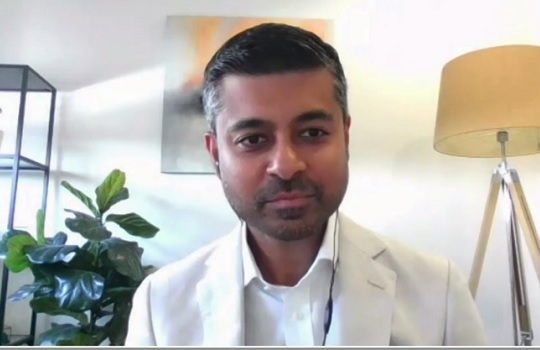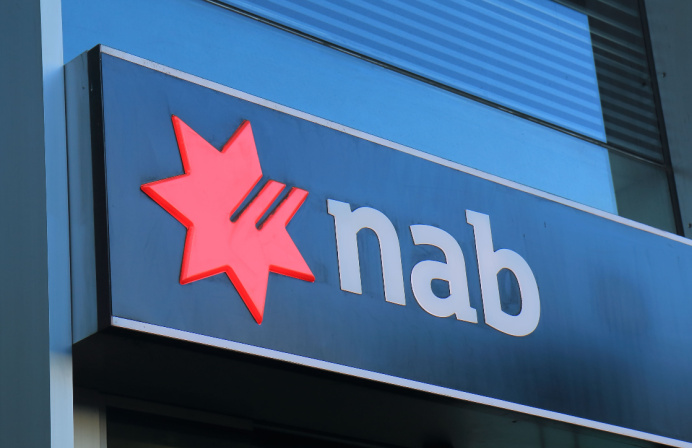
“Transformation is a sport to be played by everybody. It’s not a game that one party plays and others watch from behind.”
Joining event MC and moderator, Luke Hannan, at the recent Future of Financial Services Sydney 2020 event, Abdullah Khan, AMP’s Group Head of Technology – Modern Enterprise Infrastructure, tracks the financial services giant’s migration story from “monolithic, 90s-era architecture” to today’s ambitious all-cloud infrastructure push, strategies for managing new multi-cloud, code-rich ecosystems, and how Khan’s tech team is maximising the value of industry partnerships.
Hannon (Moderator): Let’s start by exploring AMP’s infrastructure and modernisation program to date. What does the work entail and how far along is your team in this journey?
Khan: Great question. We’re looking at infrastructure transformation in a very holistic way; as you know, transformation doesn’t work in a piecemeal fashion – you need to look at it holistically, understanding where we are and where we want to be.
From an AMP strategy perspective, we are driven to build a simplified, data-driven, and growth-oriented business. Part of bringing that to life is knowing what technology should play a role in that. From an infrastructure transformation perspective, we’re looking to simplify, to rationalise, and to highly automate our architecture. One of the key tenets of this strategy is to become a cloud-only organisation.
We want to go from a monolithic, 90s-era, fixed cost-driven architecture to a more elastic, cloud-based one, enabling interconnectedness through APIs and a modern way of interacting, while also creating a common customer consumption layer across the top.
So, the cost-to-serve becomes significantly lower and you improve the automation piece as part of that.
What’s really important though is looking at and uplifting our risk, security, and compliance posture, given that financial service organisations are driven by regulatory guidance and, at the macro level in Australia and even beyond that, we must consider the significant rise in cyber-attacks as well as ongoing risk and compliance issues – it’s one of the key pieces of our transformation strategy. And the risk awareness that comes with that enables us to delve into the programmatic code-driven guardrails that we need to establish as we democratise our production services to help clients and customers.
Hannon (Mod): You touched on simplification, rationalisation, and automation. Do they form the epicentre or the guiding principles by which AMP’s transformation is taking place, or are there other elements that are your ‘north star’?
Khan: One of our north stars is customer-centricity. We exist for our customers. We’re not building systems or services for ourselves; we’re building them to serve our customers. So, we’re always looking at customer-centric design and principles, as we apply those new emerging technologies and services, as well as focusing on the data.
Data is the gold of the new age. We put everything, whatever we do, into ensuring we have the right level of insights, and what’s more action-driven insights, to predict and respond to our customer needs.
That’s one of our real focuses. Another that was touched upon is security and risk, which is going to be our bread and butter as we move into the cloud and enable our service for wider consumption moving forward.
Hannon (Mod): Walk us through some of the key drivers for adopting cloud as part of your infrastructure overhaul.
Khan: One of the key tenets is reducing the cost of serving our customers and our internal businesses as well. That elasticity, cost to serve, and speed to market is really, really important. If you think of a business case perspective for any cloud transformation for any organisation, often we gravitate towards the hard benefits – the reduction in costs and so forth.
But the most compelling benefits of cloud transformations are your soft benefits.
I often say that soft benefits are harder than hard benefits, which differentiates a good organisation from a great organisation. That’s one of the key areas of focus for us. We’re really turbocharging our whole digitisation agenda through cloud to enable new services while it also lowers the cost of innovation and experimentation.
When we talk about cloud transformation, it’s not about going to the public cloud or migrating all our workloads there, or even just creating mode 1.0 or mode 2.0 applications in the cloud; it comes with a whole of infrastructure, holistic view. What is the current state of the network and how are we moving from a fixed, physical device-driven network to software-defined network? That’s essentially the key part of it. AMP is not just a local organisation. We have global offices in the northwest region of North America, Asia, Africa and everywhere else. Having that really improves the customer experience, where we can provide locally and globally with a software-defined network that is also at the forefront from a transformation perspective.
Hannon (Mod): Let’s talk about the transition to cloud and unlocking value beyond customer experience and data. What are some of the key drivers there?
Khan: A key driver is improving our risk and security postures. That’s vitally important. Everything gets ‘codified’, which today means treating everything as code – essentially from inception to delivery. It’s essentially our ‘secure by design’ principle. Whatever we design, we keep security as part of that. The days are gone where you simply put security on top, almost as an afterthought; more sophisticated best practices are coming.
Another piece, when you talk about speed to market, or cycle time, is how we can deliver more features, more customer intuitive capabilities and more quickly to fulfil that demand. You can’t do that if you don’t adopt the whole DevOps culture and CI/CD mentality as part of the delivery cycle. It’s also very hard to achieve that without everything being treated as code.
There is no cookie-cutter approach to transformation; every organisation has different ingrained cultures and personas that have been integrated into processes as well.
It’s more about looking at how we, as an organisation, are driving a compelling narrative to be able to achieve that outcome. And cloud fluency plays a big role there, which can be done in many ways. We’ve done that by establishing a Cloud Academy, not only for our technology communities but also for our business community. We’re bridging the gap and enabling cloud fluency across the whole organisation; that’s one of the keys to cloud adoption from an organisational perspective.
Hannon (Mod): Did AMP have the right people in place at the coalface or was there a real recruitment drive to bring people in to help complement the cloud journey?
Khan: It’s really a mix of both. As part of our Cloud Academy, we anchored that into our Future Ready Workforce Initiative. It looks at how we upscale our greatest asset, which is our people, from a skills perspective. And there are so many ways of learning for people in our organisation. It’s not just formal qualification and training; we have immersion days, hackathons, lunch and learn sessions, offering a wide suite of capabilities and opportunities. We coupled that with a burst of fresh ideas from external partners by growing and attracting talent from outside as well, creating a whole ecosystem beyond.
We don’t have to solve everything within our organisation; it’s about building a strong partner ecosystem to tap into those capabilities that guide us along as well.
It’s vitally important to build thought leadership within our organisation while also tapping into a strong partner ecosystem to ensure we’re guided by some of the key cloud leaders in the market, and tried and tested methodologies to bring value to that.
Hannon (Mod): One thing I suspect many FSI executives – either on a cloud or any other transformation journey – will experience is justifying the value of investments when the benefits aren’t necessarily easily read on a P&L. The softer benefits, as you alluded to, are harder to see. What were some of the things you did to try and get that over the line?
Khan: It’s always been, I would say, a challenge. But we’ve come a long way. But how do you quantify that? It cannot be quantified from the traditional financial modelling perspective, right? So, if we looked at it holistically – for example, from a security and risk and cyber perspective and the way we have applied that principle – if we don’t have the right controls and right improvements in our posture, we are open to exposing ourselves to a number of security threats and attacks or the risk of compliance or regulatory governance failures. If we are not in line with that, what’s the cost of managing it?
I was reading an article a few months back which showed that for a top 100 organisation, a cyber-attack costs $4 million a year on average. How does that look when creating a business case as well? And speed to market is really, really important, because that agility and nimbleness is key to differentiating ourselves. So, if you look from a core platforms perspective, and the rate of change you have today and rate of change you need to have tomorrow, how do you quantify that from a customer satisfaction perspective? There’s also the other angle of NPS which comes into play. And the traditional cost to serve is really, really important.
The other element is creating a whole narrative with your executive board. Speaking a language they understand is key – ‘making the complex simple and the simple compelling’, as a previous presentation mentioned, is a critical part of that as well. It’s not a science, it becomes an art – how do you build a narrative explaining that whole holistic value of transformation?
Hannon (Mod): In terms of partnerships, was there a cultural shift within AMP that needed to happen to realise we can’t do everything ourselves?
Khan: There was an element of a cultural shift. The first thing we did was to look at our differentiating capabilities and non-differentiating and commoditised capabilities.
One of the key principles of our sourcing has been: anything that is non-differentiating, we don’t try to do that; we give it to the market leaders who have had a tried and tested model and a fully automated way of doing it.
Anything that is differentiating, though, we try to have thought leadership within that sphere, while we also do some partner enablement or partner assistance capabilities as part of that. Once you have that view, it’s quite easy to change and shift the cultural mindset to ‘OK, these are areas we’re going towards: where are we today and where do we need to be?’
Part of our Cloud Academy is about establishing a learning need analysis. That’s really a data-driven view of where we were and where we need to be. When you put that rationalised view of skills and development matrixes based on ‘Where we are and where we need to be’, then you look at ways to plug that gap: either through a partner’s eco-systems or internally. That becomes a very contextual conversation to solve some real problems.
Hannon (Mod): Moving on to cloud providers now. What’s the thinking behind what you look for and how you source your particular cloud provider?
Khan: We strongly believe that every organisation is on its way to becoming a multi-cloud customer.
There is no one cloud that can solve all the requirements that you have.
We looked at more of a holistic approach, or ‘horses for courses’ as I call it, making sure we put the right value on the right cloud provider. However, in terms of looking at that relationship and partnership, it’s more around what is our strategic intent and what sort of capabilities we need which are natively strong from the cloud provider perspective. For example, from the hosting platform perspective, we chose a particular cloud provider for looking at some collaboration services and digital workplace services.
One of the recommendations I had going through the process is to create a cloud canvas, which lists the core capabilities you require, the business problems you want to solve, and the opportunities you want to tap into, bringing those three elements together to see which cloud providers in the market are offering those capabilities natively. Also key, which is probably further down the track, is when you have multi-cloud provider ecosystem, how can you manage those providers in a unified way? That’s also what you’ll see next moving forward over the next couple of years. It’ll be very topical. How can you have a cloud-agnostic principle and practices to manage those clouds through a partner ecosystem or through your insource perspective as well? That’s where a cloud consumption layer becomes really, really important – the level of abstractions that enables you to manage multiple cloud providers with a single team and a partner ecosystem. That’s going to be your future from a cloud economy perspective.
Hannon (Mod): We’ve spoken a lot over the past three days about Covid-19. The pivot towards remote working at AMP is obviously no different. Has this changed employee experience affected or enhanced the transformation journey?
Khan: It transformed the employee experience in the most positive way. We went from a 25 per cent to 95 per cent remote workforce in three weeks, with our current networking and current collaboration suites and so forth in place. We have never worked remotely that efficiently or continuously ever before. Without those collaboration tools, without that suite of products and services that we had in place, we wouldn’t have been able to achieve that.
What’s really become important recently is the whole embodiment of culture within the organisation, from the employee experience through to digital tools and services. I often give the example that if a new individual joined an organisation during the Covid lockdowns, how does that individual experience the organisation’s culture from their digital tools and services? Essentially, their definition of that culture will be their experience with those tools and services. That’s why we’re focused on our digital workplace transformation piece to bring that to bear and also rationalise, simplify, and pursue our cloud-only strategy.
Hannon (Mod): One of the learnings you touched upon earlier was the single team to manage your multi-cloud strategy. What other learnings have you and your team taken aboard since embarking on the cloud journey within AMP?
Khan: One is creating a really strong relationship and engagement with the business so they are part of that journey; it’s not a journey that technology teams can do alone. It’s bringing the rest of the business along for the journey to understanding what ‘great’ looks like and creating that picture collectively.
Because no transformation program would be successful without direct sponsorship from the CEO and the executive board and the direct involvement, participation, and perspective of the business.
The simple example of the Cloud Academy is key. One session we had roughly 300 people from the business join us for a ‘lunch and learn’ session to understand innovation, culture, and what cloud brings to that. We put them through some formal training as well. And that brings the conversation to: ‘Okay, great, what does it mean for me? How does it help me from a day-to-day functions perspective? What does it mean for a customer representative who’s taking phone calls from the business side of things as well?’ And it’s not just cloud. We also have different tools in our arsenal. We have robotic process automation coming into play. We’re enabling some AI-enabled chatbots as part of that. It’s about that holistic experience or the customer’s holistic experience and how we operate ourselves in the most cost-effective and optimised way.
Hannon (Mod): Were there some sticking points along the journey where it was hard to get everyone on the bus? Legacy people, legacy thinking – stepping away from that is no doubt quite a big cultural shift.
Khan: At the end of the day, as an individual, as a professional, everybody would like to future-proof themselves. And if there’s an opportunity to do that, you’ll have a lot more people on your bandwagon to help you along the way, because helping them is helping ourselves as well.
Transformation is a sport to be played by everybody, not a game that one party plays and others watch from behind. That’s why we took a really collective approach to this. And the results are really, really good. At the end of the day, it’s cultural transformation. And, as with any transformation, the key thing over and over, tried and tested, is people and culture. Technology comes later.
Hannon (Mod): Looking to the future, 2021 and 2022. What does the future hold for AMP’s infrastructure transformation?
Khan: 2021 is going to be really exciting for us. I often say that 2021 is our year of delivery from a transformation perspective. All our cloud-only strategies and future-proofing and our future-ready workforce initiatives all come to fruition next year and beyond. We’ll be looking at turbocharging our cloud transformation, turbocharging our network transformation, focusing on uplifting our data capability, and also transforming our employee digital experience as well. These are things that will start bearing fruit, providing benefits that will really transfer to our customers and our businesses as well. When all of those things come together, that’s a longer play. But the way we’re trying to deliver that transformation, it’s not a big monolithic program of work that you’ll only see the benefits of 18 months later – that’s not the way we have structured ourselves.
We’ve modularised those capabilities and grouped them together to deliver small, incremental changes, small incremental capabilities and to uplift as we go along, while also continuing to have a strong focus on the stability and resilience of services that we currently serve to customers.
I know it’s easier said than done, but that’s the way we’ve structured ourselves. And with any transformation strategy, the proof is always in how capable we are as an organisation to execute on this strategy. Thought leadership needs to go hand-in-hand with actual leadership, that’s the way we’ve started looking at it. ◼





